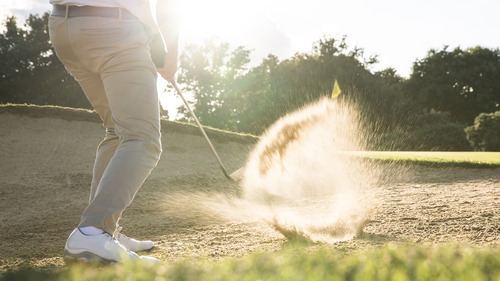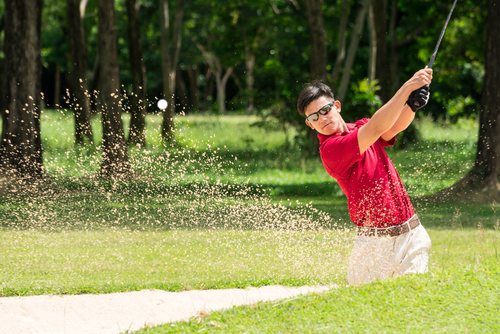4 Hacks to Improve Your Bunker Game
Jun 9th 2017
None of us like playing from the bunker—the sand can bog down any player of any level, turning a solid round into a disaster. It also, of course, means the previous shot was a missed shot in the first place! Some may neglect the intricacies of sand play to focus on fitness or the overall approach to the hole, but every golfer should spend time learning how to play their way out of trouble.

We gathered some tips from seasoned professionals and coaches about how to safely and accurately hit your ball out of a bunker.
1)Footwork
very bunker you play in will vary—and whether the difference is slight
or vast, the overall setup play is a vitally
important. Without preparing properly, the very foundations of the shot
will most likely be erroneous. When shooting from the bunker, everything needs
to fall into place; one way to reduce this margin of error is to have the correct footwork.Coach
Malcolm Young’s first tip is to familiarize yourself with the
bunker. Every bunker will be different,
so take the time to get a feel of the
sand’s texture. When setting up, placing the feet a little under the sand is
advisable to get the club under the ball during the swing.
Young’s second piece of advice is to tighten up the stance—opening it up too
much can cause difficulty with the motion of the swing and the direction of the
club. His advice for a right-handed player is a slight left foot turn coupled
with added pressure on the left knee, which can help with the motion of the
hip rotation—a common problem for casual golfers.
2)Swing

After
setting up properly (and taking out your specialist
sand wedge), it’s time to take the swing. Opening your club face, the swing should come
from “out to in” and the player should have a wrist hinge at the top—the
farther back the wrist, the farther the ball will go, so it’s important to
adjust accordingly.
It may sound counterproductive but, when hitting the ball, don’t make contact
with the ball. Hit the sand around an inch behind the ball to get optimal
yardage and accuracy.
To compound this and truly create a prime
swing, the follow through must be noted— and for sand shots, the follow-through
and the “stay down” is longer. The timing must be right—come up too early, and you’ll catch the shot thin—but
too late, and power will be lost.
3)Mental Preparation
You’re three shots into a par five
hole, but, instead of your ball laying nicely on the green, it was shanked into the greenside bunker. Even
before you’ve started to think of the difficulties of sand play, you must deal
with the frustration of the mishit.
Of course, this is the difference between a casual player, however talented, and
a professional. While the former may lose their composure, the latter will, for
the most part, maintain a calm mental state.
Even if the player manages to do so, there remains the daunting task of the
bunker shot. In this case, the key issue
is overthinking—and, with so many cues about footwork, the swing, and the follow-through,
it’s easy to do so.
Many golfers at the more casual levels see the sand as a restrictive obstacle
to getting around, and, in doing so, go
into the shot with the intention of putting excess power. Naturally, this is
counterproductive, as a more measured approach often leads to increased
accuracy.
The advice here is to cool yourself down, after hitting into the bunker, and
remain that way when taking the bunker shot—using a measured approach and
remembering your cues.
4)The Case of the Trapped Ball

Playing the next shot from a plugged lie is intimidating and calls for a special hack. Considered one of the toughest shots in golf, the plugged lie is when the ball is seemingly half buried in the sand.
Due to the nature of this shot, there are a few adjustments that must be made to your standard bunker play. First, the club should strike the sand around three inches behind the ball, as opposed to just the one. Second, the club face should be kept square, as opposed to opening it up, and the grip should be tight on the club. Last, swing aggressively—the ball will come up against a lot of resistance. Remember—the aim of this shot is to get out of the bunker and in the general direction of the green.
